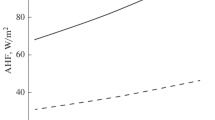Abstract
A numerical model developed by Pandolfo was used to compute changes in temperature resulting from changes in the physical characteristics of the surface due to urbanization and from the addition of radiatively active pollutants, such as a carbonaceous aerosol, that are characteristic of urbanization and industrialization. The model was simplified here by (1) omitting advection, and (2) by holding the pollutant concentration constant in time. The results show that changes in the physical properties of the surface, and not pollutants are the dominant factors in creating the urban heat island. Changes in the vertical thermal structure are caused by changes in the surface temperature near the surface and by the presence of pollutants at higher levels.
Similar content being viewed by others
References
Atwater, M. A.: 1971a, ‘Radiative Effects of Pollutants in the Atmospheric Boundary Layer’,J. Atmos. Sci. 28, 1367–1373.
Atwater, M. A.: 1971b, ‘The Radiation Budget for Polluted Layers of the Urban Environment’,J. Appl. Meteor. 10, 205–214.
Bach, W.: 1971, ‘Variation of Solar Attenuation with Height over an Urbanized Area’,J. Air Poll. Contr. Assoc. 21, 621–628.
Bornstein, R. D.: 1968, ‘Observations of the Urban Heat Island Effect in New York City’,J. Appl. Meteor. 7, 575–582.
Clarke, J. F.: 1969, ‘Nocturnal Boundary Layer Over Cincinnati, Ohio’,Mo. Wea. Rev. 97, 582–589.
Halstead, M. H., Richman, R., Covey, W., and Merryman, J.: 1957, ‘A Preliminary Report on the Design of a Computer for Micrometeorology’,J. Meteor. 14, 308–325.
Haurwitz, B.: 1941,Dynamic Meteorology, McGraw-Hill Book Co., New York, p. 9.
Howard, L.: 1833,Climate of London Deduced from Meteorological Observations, Harvey and Darton, 3rd Ed., London, 165 pp.
Kondrat'yev, K.: 1969,Radiation in the Atmosphere, Academic Press, New York, 912 pp.
Landsberg, H. E.: 1956, ‘The Climate of Towns’,Man 's Role in Changing the Face of the Earth, Univ. of Chicago Press, Chicago, Ill. 584–606.
Leahey, D. M. and Friend, J. P.: 1971, ‘A Model for Predicting the Depth of the Mixing Layer over an Urban Heat Island with Applications to New York City’,J. Appl. Meteor. 10, 1162–1173.
McDonald, J. E.: 1960, ‘Direct Absorption of Solar Radiation by Atmospheric Water Vapor’,J. Meteor. 17, 319–328.
Myrup, L.O.: 1969, ‘A Numerical Model of the Urban Heat Island’,J. Appl. Meteor. 8, 908–918.
Myrup, L. O.: 1970, ‘Corrigendum to Myrup, L. O., 1969’,J. Appl. Meteor. 9, 541.
Oke, T. R. and East, C.: 1971, ‘The Urban Boundary Layer in Montreal’,Boundary-Layer Meteor. 1, 411–437.
Pandolfo, J. P.: 1966, ‘Wind and Temperature Profiles for Constant Flux Boundary Layers in Lapse Conditions with a Variable Eddy Conductivity to Eddy Viscosity Ratio’,J. Atmos. Sci. 23, 495–502.
Pandolfo, J. P.: 1969, ‘Motions with Inertial and Diurnal Period in a Numerical Model of the Navi-facial Boundary Layer’,J. Mar. Res. 27, 301–317.
Peterson, J. T.: 1969,The Climate of Cities: A Survey of Recent Literature, NAPCA Publ. No. AP-59 U.S. Government Printing Office, Washington, D.C., 48 pp.
Sheppard, P. A.: 1958, ‘The Effect of Pollution on Radiation in the Atmosphere’,Intern. J. Air Water Poll. 1, 31–43.
SMIC: 1971, ‘Inadvertant Climate Modification’, Report of theStudy of Man's Impact on Climate (SMIC), MIT Press, Cambridge, Mass., 308 pp.
Twitty, J. T. and Weinman, J. A.: 1971, ‘Radiative Properties of Carbonaceous Aerosol’,J. Appl. Meteor. 10, 725–731.
Zdunkowski, W. G. and Trask, D. C.: 1971, ‘Application of a Radiative-Conductive Model to the Simulation of Nocturnal Temperature Changes over Different Soil Type’,J. Appl. Meteor. 10, 937–948.
Author information
Authors and Affiliations
Rights and permissions
About this article
Cite this article
Atwater, M.A. Thermal effects of urbanization and industrialization in the boundary layer: A numerical study. Boundary-Layer Meteorol 3, 229–245 (1972). https://doi.org/10.1007/BF02033921
Received:
Issue Date:
DOI: https://doi.org/10.1007/BF02033921




